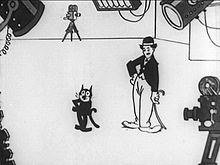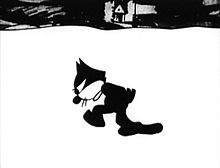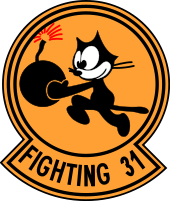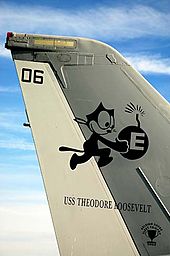
Felix the Cat
Background Information
SOS Children have produced a selection of wikipedia articles for schools since 2005. Visit the SOS Children website at http://www.soschildren.org/
Felix the Cat is a funny animal cartoon character created in the silent film era. The anthropomorphic black cat with his black body, white eyes, and giant grin, coupled with the surrealism of the situations in which his cartoons place him, combine to make Felix one of the most recognized cartoon characters in film history. Felix was the first character from animation to attain a level of popularity sufficient to draw movie audiences.
Felix's origins remain disputed. Australian cartoonist/ film entrepreneur Pat Sullivan, owner of the Felix character, claimed during his lifetime to be its creator. American animator Otto Messmer, Sullivan's lead animator, has been credited as such. What is certain is that Felix emerged from Sullivan's studio, and cartoons featuring the character enjoyed success and popularity in 1920s popular culture. Aside from the animated shorts, Felix starred in a comic strip (drawn by Messmer) beginning in 1923, and his image soon adorned merchandise such as ceramics, toys and postcards. Several manufacturers made stuffed Felix toys. Jazz bands such as Paul Whiteman's played songs about him (1923's "Felix Kept On Walking" and others).
By the late 1920s with the arrival of sound cartoons Felix's success was fading. The new Disney shorts of Mickey Mouse made the silent offerings of Sullivan and Messmer, who were then unwilling to move to sound production, seem outdated. In 1929, Sullivan decided to make the transition and began distributing Felix sound cartoons through Copley Pictures. The sound Felix shorts proved to be a failure and the operation ended in 1932. Sullivan died in 1933. Felix saw a brief three cartoon resurrection in 1936 by the Van Beuren Studios.
Felix cartoons began airing on American TV in 1953. Joe Oriolo introduced a redesigned, "long-legged" Felix, added new characters, and gave Felix a "Magic Bag of Tricks" that could assume an infinite variety of shapes at Felix's behest. The cat has since starred in other television programs and in two feature films. As of the 2010s, Felix is featured on a variety of merchandise from clothing to toys. Oriolo's son, Don Oriolo, later assumed creative control of Felix.
In 2002, TV Guide ranked Felix the Cat number 28 on its "50 Greatest Cartoon Characters of All Time" list.
Creation
On November 9, 1919, Master Tom, a prototype of Felix, debuted in a Paramount Pictures short entitled Feline Follies. Produced by the New York City-based animation studio owned by Pat Sullivan, the cartoon was directed by cartoonist and animator Otto Messmer. It was a success, and the Sullivan studio quickly set to work on producing another film featuring Master Tom, the Felix the Cat prototype in The Musical Mews (released 16 November 1919). It too proved to be successful with audiences. Otto Messmer gave two different versions of how Felix got his name, the one on his official site ”Rejoining Sullivan with a great idea for a new character named Felix the Cat, and the second that ”Mr. (John) King of Paramount Magazine suggested the name "Felix", after the Latin words felis (cat) and felix (lucky), which was used for the third film, The Adventures of Felix (released on 14 December 1919). Pat Sullivan said he named Felix after Australia Felix from Australian history and literature. In 1924, animator Bill Nolan redesigned the fledgling feline, making him both rounder and cuter. Felix's new looks, coupled with Messmer's character animation, brought Felix to fame.
The question of who created Felix remains a matter of dispute. Sullivan stated in numerous newspaper interviews that he created Felix and did the key drawings for the character. On a visit to Australia in 1925, Sullivan told The Argus newspaper that "The idea was given to me by the sight of a cat which my wife brought to the studio one day." On other occasions, he claimed that Felix had been inspired by Rudyard Kipling's " The Cat that Walked by Himself" or by his wife's love for strays. Members of the Australian Cartoonist Association have demonstrated that lettering used in Feline Follies matches Sullivan's handwriting. Pat Sullivan also lettered within his drawings which was a major contradiction to Messmer's claims. Sullivan's claim is also supported by his 18 March 1917, release of a cartoon short entitled The Tail of Thomas Kat, more than two years prior to Feline Follies. Both an Australian ABC-TV documentary screened in 2004 and the curators of an exhibition at the State Library of New South Wales, in 2005, suggested that Thomas Kat was a prototype or precursor of Felix. However, few details of Thomas have survived. His fur colour has not been definitively established, and the surviving copyright synopsis for the short suggests significant differences between Thomas and the later Felix. For example, whereas the later Felix magically transforms his tail into tools and other objects, Thomas is a non- anthropomorphized cat who loses his tail in a fight with a rooster, never to recover it.
Sullivan was the studio proprietor and—as is the case with almost all film entrepreneurs—he owned the copyright to any creative work by his employees. In common with many animators at the time, Messmer was not credited. After Sullivan's death in 1933, his estate in Australia took ownership of the character.
It was not until many years after Sullivan's death that Sullivan staffers such as Hal Walker, Al Eugster, and Sullivan's lawyer, Harry Kopp, credited Messmer with Felix's creation. They claimed that Felix was based on an animated Charlie Chaplin that Messmer had animated for Sullivan's studio earlier on. The down-and-out personality and movements of the cat in Feline Follies reflect key attributes of Chaplin's, and, although blockier than the later Felix, the familiar black body is already there (Messmer found solid shapes easier to animate). Messmer himself recalled his version of the cat's creation in an interview with animation historian John Canemaker:
Sullivan's studio was very busy, and Paramount, they were falling behind their schedule and they needed one extra to fill in. And Sullivan, being very busy, said, "If you want to do it on the side, you can do any little thing to satisfy them." So I figured a cat would be about the simplest. Make him all black, you know—you wouldn't need to worry about outlines. And one gag after the other, you know? Cute. And they all got laughs. So Paramount liked it so they ordered a series.
Many animation historians (most of them American or English) back Messmer's claims. Among them are Michael Barrier, Jerry Beck, Colin and Timothy Cowles, Donald Crafton, David Gerstein, Milt Gray, Mark Kausler, Leonard Maltin, and Charles Solomon.
Regardless of who created Felix, Sullivan marketed the cat relentlessly, while Messmer continued to produce a prodigious volume of Felix cartoons. Messmer did the animation directly on white paper with inkers tracing the drawings directly. The animators drew backgrounds onto pieces of celluloid, which were then laid atop the drawings to be photographed. Any perspective work had to be animated by hand, as the studio cameras were unable to perform pans or trucks. Messmer began a comic strip in 1923, distributed by King Features Syndicate.
Popularity and distribution
Paramount Pictures distributed the earliest films from 1919 to 1921. Margaret J. Winkler distributed the shorts from 1922 to 1925, the year when Educational Pictures took over the distribution of the shorts. Sullivan promised them one new Felix short every two weeks. The combination of solid animation, skillful promotion, and widespread distribution brought Felix's popularity to new heights.
References to alcoholism and Prohibition were also commonplace in many of the Felix shorts, particularly Felix Finds Out (1924), Whys and Other Whys (1927), Felix Woos Whoopee (1930) to name a few. In Felix Dopes It Out (1924), Felix tries to help his hobo friend who is plagued with a red nose. By the end of the short, the cat finds the cure for the condition: "Keep drinking, and it'll turn blue."
In addition, Felix was one of the first images ever broadcast by television when RCA chose a papier-mâché Felix doll for a 1928 experiment via W2XBS New York in Van Cortlandt Park. The doll was chosen for its tonal contrast and its ability to withstand the intense lights needed. It was placed on a rotating phonograph turntable and photographed for approximately two hours each day. After a one-time payoff to Sullivan, the doll remained on the turntable for nearly a decade as RCA fine-tuned the picture's definition.
Felix's great success also spawned a host of imitators. The appearances and personalities of other 1920s feline stars such as Julius of Walt Disney's Alice Comedies, Waffles of Paul Terry's Aesop's Film Fables, and especially Bill Nolan's 1925 adaptation of Krazy Kat (distributed by the eschewed Winkler) all seem to have been directly patterned after Felix.
Felix's cartoons were also popular among critics. They have been cited as imaginative examples of surrealism in filmmaking. Felix has been said to represent a child's sense of wonder, creating the fantastic when it is not there, and taking it in stride when it is. His famous pace—hands behind his back, head down, deep in thought—became a trademark that has been analyzed by critics around the world. Felix's expressive tail, which could be a shovel one moment, an exclamation mark or pencil the next, serves to emphasize that anything can happen in his world. Aldous Huxley wrote that the Felix shorts proved that "What the cinema can do better than literature or the spoken drama is to be fantastic."
By 1923, the character was at the peak of his film career. Felix in Hollywood, a short released during this year, plays upon Felix's popularity, as he becomes acquainted with such fellow celebrities as Douglas Fairbanks, Cecil B. DeMille, Charlie Chaplin, Ben Turpin, and even censor Will H. Hays. His image could be seen on clocks (not to be confused with the Kit-Cat Klock), Christmas ornaments, and as the first giant balloon ever made for Macy's Thanksgiving Day Parade. Felix also became the subject of several popular songs of the day, such as "Felix Kept Walking" by Paul Whiteman. Sullivan made an estimated $100,000 a year from toy licensing alone. With the character's success also emerged a handful of new costars. These included Felix's master Willie Jones, a mouse named Skiddoo, Felix's nephews Inky, Dinky, and Winky, and his girlfriend Kitty. Felix the Cat sheet music, with music by Pete Wendling and Max Kortlander, featuring lyrics by Alfred Bryan, was published in 1928 by Sam Fox Publishing Company. The cover art of Felix playing a banjo was done by Otto Messmer and was subtitled " Pat Sullivan's Famous Creation in Song."
Most of the early Felix cartoons mirrored American attitudes of the " Roaring Twenties". Ethnic stereotypes appeared in such shorts as Felix Goes Hungry (1924). Recent events such as the Russian Civil War were depicted in shorts like Felix All Puzzled (1924). Flappers were caricatured in Felix Strikes It Rich (1923). He also became involved in union organizing with Felix Revolts (also 1923). In some shorts, Felix even performed a rendition of the Charleston.
In 1928, Educational ceased releasing the Felix cartoons and several were reissued by First National Pictures. Copley Pictures distributed them from 1929 to 1930. He saw a brief three-cartoon resurrection in 1936 by the Van Beuren Studios (The Goose That Laid the Golden Egg, Neptune Nonsense and Bold King Cole). Sullivan did most of the marketing for the character in the 1920s. In these Van Beuren Studios shorts, Felix spoke and sang in a high pitched childlike voice provided by Walter Tetley, a popular radio actor in the 1930s and 1940s ("Julius" on the The Phil Harris-Alice Faye Show, and "Leroy" on The Great Gildersleeve, however best known later in the 1960s as the voice of Sherman on the Bullwinkle Show's Mister Peabody segments.
Felix as mascot
Given the character's unprecedented popularity and the fact that his name was partially derived from the Latin word for "lucky", some rather notable individuals and organizations adopted Felix as a mascot. The first of these was a Los Angeles Chevrolet dealer and friend of Pat Sullivan named Winslow B. Felix who first opened his showroom in 1921. The three-sided neon sign of Felix Chevrolet, with its giant, smiling images of the character, is today one of LA's best-known landmarks, standing watch over both Figueroa Street and the Harbour Freeway. Others who adopted Felix included the 1922 New York Yankees and aviator Charles Lindbergh, who took a Felix doll with him on his historic flight across the Atlantic Ocean.
This popularity persisted. In the late 1920s, the U.S. Navy's Bombing Squadron Two (VB-2B) adopted a unit insignia consisting of Felix happily carrying a bomb with a burning fuse. They retained the insignia through the 1930s when they became a fighter squadron under the designations VF-6B and, later, VF-3, whose members Edward O'Hare and John Thach became famous naval aviators in World War II. After the world war a U.S. Navy fighter squadron currently designated VFA-31 replaced its winged meat-cleaver logo with the same insignia, after the original Felix squadron had been disbanded. The carrier-based night-fighter squadron, nicknamed the "Tomcatters," remained active under various designations continuing through the present day and Felix still appears on both the squadron's cloth jacket patches and aircraft, carrying his bomb with its fuse burning.
Felix is also the oldest high school mascot in the state of Indiana, chosen in 1926 after a Logansport High School player brought his plush Felix to a basketball game. When the team came from behind and won that night, Felix became the mascot of all the Logansport High School sports teams.
The pop punk band The Queers also use Felix as a mascot, often drawn to reflect punk sensibilities and attributes such as scowling, smoking, or playing the guitar. Felix adorns the covers of both the Surf Goddess EP and the Move Back Home album. Felix also appears in the music video for the single "Don't Back Down". Besides appearing on the covers and liner notes of various albums the iconic cat also appears in merchandise such as t-shirts and buttons. In an interview with bassist B-Face, he asserts that Lookout! Records is responsible for the use of Felix as a mascot.
Felix appeared in a Japanese commercial for the 1991 Daihatsu Mira as "Felix the Mira".
From silent to sound
With the advent of The Jazz Singer in 1927, Educational Pictures, who distributed the Felix shorts at the time, urged Pat Sullivan to make the leap to " talkie" cartoons, but Sullivan refused. Further disputes led to a break between Educational and Sullivan. Only when Walt Disney's Steamboat Willie made cinematic history as the first talking cartoon with a synchronized soundtrack ( My Old Kentucky Home from Max and Dave Fleischer's Ko-Ko Song Car-Tunes preceded Willie, but did not gain the same recognition) did Sullivan see the possibilities of sound. He managed to secure a contract with First National Pictures in 1928. However, for reasons unknown, this did not last, so Sullivan sought out Jacques Kopfstein and Copley Pictures to distribute his new sound Felix cartoons. On 16 October 1929, an advertisement appeared in Film Daily with Felix announcing, Jolson-like, "You ain't heard nothin' yet!"
Unfortunately, Felix's transition to sound was not a smooth one. Sullivan did not carefully prepare for Felix's transition to sound, and added sound effects into the sound cartoons as a post-animation process. The results were disastrous. More than ever, it seemed as though Disney's mouse was drawing audiences away from Sullivan's silent star. Not even entries such as the off-beat "Felix Woos Whoopee"(1931)or the Silly Symphony-esque April Maze (both 1930) could regain the franchise's audience. Kopfstein finally canceled Sullivan's contract. Subsequently, he announced plans to start a new studio in California, but such ideas never materialized. Things went from bad to worse when Sullivan's wife, Marjorie, died in March 1932. After this, Sullivan completely fell apart. He slumped into an alcoholic depression, his health rapidly declined, and his memory began to fade. He could not even cash checks to Messmer because his signature was reduced to a mere scribble. He died in 1933. Messmer recalled, "He left everything a mess, no books, no nothing. So when he died the place had to close down, at the height of popularity, when everybody, RKO and all of them, for years they tried to get hold of Felix ... I didn't have that permission [to continue the character] 'cause I didn't have legal ownership of it."
In 1935, Amadee J. Van Beuren of the Van Beuren Studios called Messmer and asked him if he could return Felix to the screen. Van Beuren even stated that Messmer would be provided with a full staff and all of the necessary utilities. However, Messmer declined his offer and instead recommended Burt Gillett, a former Sullivan staffer who was now heading the Van Beuren staff. So, in 1936, Van Beuren obtained approval from Sullivan's brother to license Felix to his studio with the intention of producing new shorts both in colour and with sound. With Gillett at the helm, now with a heavy Disney influence, he did away with Felix's established personality and made him just another funny-animal character of the type popular in the day. The new shorts were unsuccessful, and after only three outings Van Beuren discontinued the series.
Revival
In 1953, Official Films purchased the Sullivan–Messmer shorts, added soundtracks to them, and distributed to the home movie and television markets. Messmer himself pursued the Sunday Felix comic strips until their discontinuance in 1943, when he began eleven years of writing and drawing Felix comic books for Dell Comics that were released every other month. In 1954, Messmer retired from the Felix daily newspaper strips, and his assistant Joe Oriolo (the creator of Casper the Friendly Ghost) took over. Oriolo struck a deal with Felix's new owner, Pat Sullivan's nephew, to begin a new series of Felix cartoons on television. Oriolo went on to star Felix in 260 television cartoons distributed by Trans-Lux beginning in 1958. Like the Van Beuren studio before, Oriolo gave Felix a more domesticated and pedestrian personality, geared more toward children, and introduced now-familiar elements such as Felix's Magic Bag of Tricks, a satchel that could assume the shape and characteristics of anything Felix wanted. The show did away with Felix's previous supporting cast and introduced many new characters, all of which were performed by voice actor Jack Mercer.
Oriolo's plots revolve around the unsuccessful attempts of the antagonists to steal Felix's Magic Bag, though in an unusual twist, these antagonists are occasionally depicted as Felix's friends as well. The cartoons proved popular, but critics have dismissed them as paling in comparison to the earlier Sullivan–Messmer works, especially since Oriolo aimed the cartoons at children. Limited animation (required due to budgetary restraints) and simplistic story lines did nothing to diminish the series' popularity.
In 1970, Oriolo gained complete control of the Felix character, and continues to promote the character to this day.
In the late 1980's, after his father's death, Don Oriolo teamed up with European animators to work on the character's first feature film, Felix the Cat: The Movie. In the film, Felix visits an alternate reality along with the Professor and Poindexter. New World Pictures planned a 1987 Thanksgiving release for U.S. theaters, which did not happen; the movie went direct-to-video in August 1991. In 1995, Felix appeared on television again, in the series The Twisted Tales of Felix the Cat. Baby Felix followed in 2000 for the Japanese market, and also the direct-to-video Felix the Cat Saves Christmas. Felix co-starred with Betty Boop in the Betty Boop and Felix comic strip (1984–1987). Oriolo has also brought about a new wave of Felix merchandising, including Wendy's Kids Meal toys and a video game for the Nintendo Entertainment System.
According to Don Oriolo's Felix the Cat blog, as of September 2008 there were plans in development for a new television series. Oriolo's biography page also mentions a 52-episode cartoon series then in the works, titled The Felix the Cat Show, which was slated to use CG graphics.
Home video
DVD releases include Presenting Felix the Cat from Bosko Video; Felix! from Lumivision; Felix the Cat: The Collector's Edition from Delta Entertainment; and Before Mickey from Inkwell Images Ink. Some of the TV series cartoons (from 1958 to 1959) were released on DVD by Classic Media, now known as DreamWorks Classics, due to the DreamWorks Animation acquisition. Some of the 1990s series has also been released.
Filmography
Voice actors
Felix was silent until 1936, when the sudden popularity of Mickey Mouse prompted the animators to put Felix cartoons in sound.
- Mae Questel (1936)
- Jack Mercer (1958–1961)
- Chris Phillips (1988)
- Thom Adcox-Hernandez/ Charlie Adler (1995–1997)
- Fred Newman (2004)
- Dave Coulier (official)
- Carlos Alazraqui (current voice)
Legacy
- In 2004, Felix was voted among the 100 Greatest Cartoons in a poll conducted by the British television channel Channel 4, ranking at #89.
- In the same year, Felix was named #36 in Animal Planet's 50 Greatest Movie Animals.
- In 2002, Felix was voted in TV Guide's 50 greatest cartoon characters of all time, ranking #28.
In popular culture
- Felix makes a few cameo appearances in Disney and Amblin Entertainment film Who Framed Roger Rabbit. He first appears as the picture in hand with R.K. Maroon in Maroon's Office, and later appears as the masks of tragedy and comedy on the keystone of the entrance to Toontown.
- Felix the Cat was featured on the NHL goalie Félix Potvin's helmet while he played for the Boston Bruins. "The Cat" had been Potvin's nickname dating back to his days with the Toronto Maple Leafs.
- In Japan, two commercials for the 1991 Daihatsu Mira featured Felix. There was a special trim-package called "Felix the Mira" offered at the time.
- In Italy, Felix was called Mio Mao under Fascism, and was published by Corriere dei Piccoli.
- The cartoon My Life As a Teenage Robot features a diner called "Mezmer's" (named after Otto Messmer), and the doorway to the restaurant is a giant Felix the Cat head.
- In an episode of The Simpsons, Dean Scungio quotes from The Encyclopaedia of Animated Cartoons on the history of Felix: "A Felix doll became Charles Lindbergh's companion on his famed flight across the Atlantic." Another episode of The Simpsons, in which the origins of the cartoon characters Itchy & Scratchy are explored, parallels some of the disputed history Felix's creation set forth above, and includes a spoof film entitled Manhattan Madness, presented as the first Itchy & Scratchy cartoon, supposedly from 1919, that is similar in style to "Felix in Hollywood" and other early Felix animations.
- Felix appeared in the 1927 Macy's Thanksgiving Day Parade, making him the first balloon to float in the parade. Unfortunately, when the balloons were released, he got tangled in some phone wires and caught fire. The fire was put out, but Felix was shelved.
- Felix appeared in opening credits of Futurama episodes " How Hermes Requisitioned His Groove Back", " The Lesser of Two Evils" and " War Is the H-Word".
- Felix is also a cat food in Europe.
- Felix plush dolls appeared in the music videos for "Pay for Me" by Whale and " My Favorite Game" by The Cardigans, both by Jonas Åkerlund.
- Part of a Felix cartoon was played in the 2002 film 100 Women, by a projector that Sam was using to play the cartoon on Hope's building.
- American DJ Felix da Housecat used Felix as an inspiration for his stage name.
- It is believed that Naoto Oshima was inspired by Felix the Cat for the design and creation of Sonic The Hedgehog while working at Sega.
- In the Lee J. Ames book Draw 50 Cats, readers are shown how to draw Felix the Cat step-by-step.










